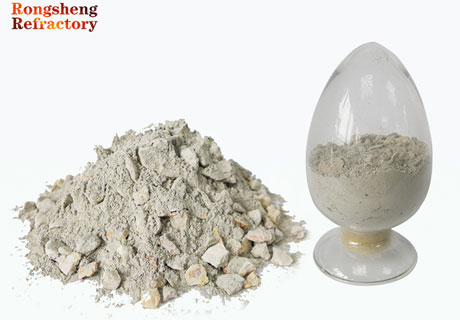Refractory castables and refractory plastics are unshaped refractory materials. They are both composed of refractory aggregates, powders, binders, etc. In addition to different construction methods, refractory castables and refractory plastics have different uses.
1. Refractory castable
Many properties of refractory castables depend to an appropriate extent on the type and amount of binder. In terms of strength, except for those made of lightweight particles, since the strength of the pellets is generally higher than the strength of the binder hardened body and the bonding strength between it and the particles, the strength of the castable actually depends on The bonding strength of the bonding agent.
The fluidity of refractory castables is generally higher than that of refractory ramming materials. Therefore, most refractory castables only need to be poured or shaken to make the mixed components densely packed and fill the model. After the castable is formed, appropriate methods must be used to promote hardening based on the hardening characteristics of the binder. For example, cement must be protected under appropriate moist conditions. For some metals, inorganic salts need to be dried and baked, etc.
The high-temperature properties of refractory castables are also closely related to the type and amount of binder. If the selected granular and powdery materials have good fire resistance, and the melting point of the binder is high but does not react with the refractory materials to form low-melt materials, the refractory castable must have fairly high fire resistance. If the lining of the granular and powdery materials used is certain, the fire resistance of the refractory castable is controlled to a certain extent by the binder, because most or most or even all of the castables made of general aluminate cement The fusible components of refractory castables are always included in the cement stone, so the amount of cement has a significant impact on the high-temperature properties of refractory castables.
2. Refractory plastic
Refractory refractory material (plastic refractory material) is an unshaped refractory material that has high plasticity over a long period of time and is in the form of ooze. It is composed of refractory particles and fines, binder, plasticizer and moisture. Granules and fine powders can be prepared from various materials, but aluminum silicate refractory materials are now widely used. When making plastic refractory materials from particles and fine powders of aluminum silicate refractory materials, soft clay is often used as the binder. In order to improve the drying strength of the plastic, a certain amount of water glass, phosphoric acid, etc. is usually added to the plastic. Aluminum sulfate and other cementing materials. Aluminum silicate is plastic and is now widely used in ramming linings of various industrial furnaces and as partial repair of linings of thermal equipment.
Castable manufacturer Rongsheng Refractory Materials produces non-stick aluminum castables, low-cement castables, high-aluminum castables, lightweight castables, refractory castables, wear-resistant castables, etc. Rongsheng Refractory Materials has successively developed aluminum silicate series, siliceous series, alkaline series, lightweight insulation brick series and other shaped products for industries such as coking, building materials, steel, nonferrous metals, and electric power, as well as castables, self-flowing materials, and refractory materials of different materials. Plastic and other unshaped materials.



